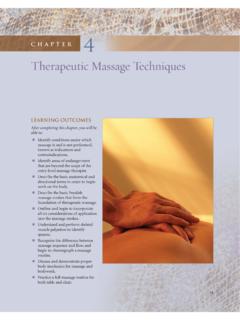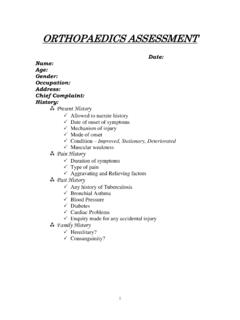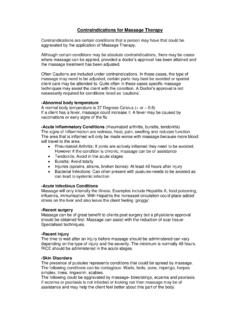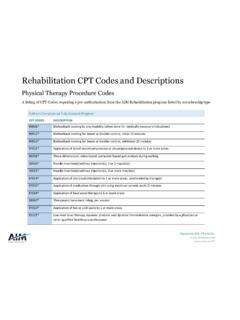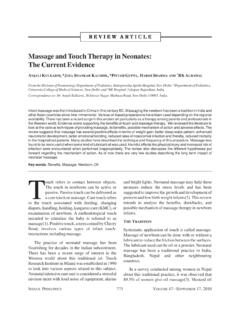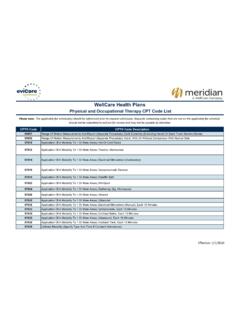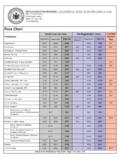Transcription of Therapeutic Massage Techniques - Physioblasts.Org
1 73 Chapter4 Therapeutic Massage TechniquesLearning OutcomesAfter completing this chapter, you will beable to: Identify conditions under whichmassage is and is not performed,known as indications andcontraindications. Identify areas of endangermentthat are beyond the scope of theentry-level Massage therapist. Describe the basic anatomical anddirectional terms in order to beginwork on the body. Describe the basic Swedishmassage strokes that form thefoundation of Therapeutic Massage . Outline and begin to incorporateall six considerations of applicationinto the Massage strokes. Understand and perform skeletalmuscle palpation to identifyspasms. Recognize the difference betweenmassage sequence and flow, andbegin to choreograph a massageroutine. Discuss and demonstrate properbody mechanics for Massage andbodywork. Practice a full Massage routine forboth table and andContraindications74 Part IBasic Concepts of Therapeutic Massage and Western-oriented Massage , whether it focuses on relaxation or more highly skilled work, is based onSwedish Massage and the strokes first formulated by a Swedish fencing master.
2 The term Swedishis oftenused to refer to a light or relaxation Massage , whereas the term Therapeutic massagedenotes a morecontemporary Massage that is corrective or considerationsor elements dictate the specifics of each stroke, such as amount of pressure,the speed with which it is applied, and the length of time the stroke lasts. Your ability as a Massage thera-pist to blend these considerations (or mechanics) with fluid movements creates a complete and fully sat-isfying Massage that will appeal to a variety of the entry-level Massage therapist, general guidelines specify conditions where Massage is and isnot warranted, commonly known as indications and contraindications. Further, there are areas of thebody known as areas of endangermentthat require advanced training and are, therefore, not within thescope of this text.
3 For safety reasons, these precautions must be understood early on in the therapist straining. However, all Massage therapists should follow the old adage, When in doubt, don t and themedical credo Do no harm. Key Termsareas of endangerment (p. 76)compression (p. 86)considerations (p. 74)contusion (p. 79)cramps (p. 79)cross-stretch (p. 86)depth or depth of pressure (p. 80)direction (p. 81)duration (p. 81)effleurage (p. 81)fine tremulous (p. 86)frequency (p. 81)friction (p. 84)hypertrophy (p. 79)indications and contraindications(p. 74) Massage flow (p. 88) Massage sequence (p. 88) Massage therapist s intent (p. 89)Meissner s corpuscles (p. 80)muscle atrophy (p. 79)nerve stroke (p. 86)palpation (p. 76)petrissage (p. 83)prone (p. 88)rhythm (p. 81)rocking (p. 86)shaking(p. 86)skin rolling (p. 86)spasm(p. 78)speed of the stroke (p.)
4 81)strains (p. 79)supine(p. 88)tapotement (p. 85)thumb presses (p. 88)vibration (p. 85)wringing (p. 86) Massage therapists often find themselves in situations where they must ask the seem-ingly simple question: Can this person receive a Massage at this time? There are a fewguidelines to follow that clearly state instances in which, or conditions where, massageis recommended (indicated) and instances in which, or conditions where, Massage isnot recommended (contraindicated). technique EMPHASISTo complicate matters further, some conditions arelocal contraindications (so the rest of the body may receive Massage ), while someconditions may require a different Massage are basic guidelines that will aid you in your decision. For an in-depth lookat possible ramifications of working with clients taking medications, see chapter mentioned in the Introduction and Overview, there are numerous benefits to receiv-ing a Massage and just as many conditions for which Massage is indicated.
5 First 4 Therapeutic Massage Techniques75foremost, circulatory Massage , such as Swedish Massage , increases circulation. The in-dividual cells of the body depend on an abundant supply of blood and lymph. Thesefluids supply nutrients and oxygen to the body as well as carry away wastes and , Massage simply helps promote overall good facilitates the smooth flow of energy and communication among the car-diovascular, digestive, urinary, respiratory, lymphatic, and nervous systems creatinghomeostasis (constancy and balance in the body). With reference to the integumentarysystem, Massage can often enhance skin condition. Massage directly improves the func-tion of the oil and sweat glands that keep the skin lubricated, clean, and cooled. Tough,inflexible skin can become softer and more supple following Massage . A healthier, moreyouthful appearance may be the also aids recovery from soft tissue injuries, such as sprains and strains.
6 Thegrowth and repair of tissues are accelerated by efficient circulation in the injured areasand appropriate stimulation of the healing tissues. Therefore, Massage therapy can of-ten help accelerate and improve recovery as well as reduce discomfort from such in-juries (see chapter 13).Finally, Massage can have a calming effect on people who are high-strung ( TypeA personalities) and people who have become dependent on pharmaceuticals or alco-hol for rest and relaxation (although it should never replace physician-prescribed med-ications for diagnosed mental or emotional disorders). Massage balances the nervoussystem by soothing or stimulating nerves and neural pathways, depending on which ef-fect is needed by the individual at the time of the afflictions such as muscle tightness and tension, insomnia, and tensionheadache caused by stress; spasms and cramps (charley horses) resulting from sportsactivities; digestive disorders (including constipation and spastic colon) encouraged bya hectic lifestyle; arthritis, asthma, fibromyalgia, sinusitis, and temporomandibularjoint dysfunction caused by certain pathologies; carpal tunnel syndrome and thoracicoutlet syndrome caused by repetitive motions; and postural imbalances caused by tem-porary conditions such as pregnancy or genetic conditions such as scoliosis all warrantmassage (see Introduction and Overview, and chapter 5).
7 Generally, anytime a massagewill be beneficial to the person and no underlying causes of concern such as disease orcirculatory problems exist, it is considered an may be general or local, specific to certain modalities, or determinedby medication use. Circulatory Massage is considered a total contraindication in situa-tions in which any modification, modality, or location would result in unsafe condi-tions. A circulatory Massage is defined as any Massage modality, such as Swedish, thatdirectly moves blood and lymph through the body, as opposed to an acupressure mas-sage that works on meridians, and indirectly affects the blood and lymph a client has a severe condition ( , severe insulin-dependent diabetes orhigh blood pressure), total or full-body circulatory Massage is contraindicated. Edemadue to any heart, lung, liver, or kidney dysfunction is a contraindication for Massage .
8 Theresponse to touch (reflex effect on nervous system) could make the disease worse. In car-diovascular diseases, Massage could dislodge a thrombus (blood clot), resulting in anembolus (floating blood clot) and causing heart attack or stroke. Abnormally high bodytemperature, often an indication of acute infection, is a contraindication for to Massage such as refraining from working on a certain area (local)can be made to allow Massage to the rest of the body. For example, you should not mas-sage distal to (or below) varicose veins so you do not further damage already compro-mised veins, but you may proceed with Massage on the rest of the body (or massageproximal to, above, the veins). Never perform Massage over open wounds, lesions, orother potentially infectious grey areas exist in which the therapist must draw on training and practicalexperience to make an educateddecision as to whether or not the client may receive aThe Art ofSkeletal MusclePalpationDirectionalTe r m sAreas ofEndangerment76 Part IBasic Concepts of Therapeutic Massage and In some cases, it might be a quality of life issue.
9 A terminally ill client, as in thecase of a cancer or AIDS patient, would benefit from the touch of a skilled and compas-sionate therapist. In other cases, under a doctor s guidance, a client may receive a spot or area-specific Massage to alleviate pain. If you question whether or not you shouldmassage a client or specific area, do not do so until you have further clarification fromanother health care professional. It is far better to lose one Massage than cause harm toa client. If your gut says no, listen!Depending on the situation, you may be able to switch to another modality, suchas Thai Massage or Reiki. For example women who are breast cancer survivors may ben-efit from Thai Massage or shiatsu. A small amount of localized acupressure Massage andgentle stretching can be both relaxing and balancing for women emerging from a verydifficult time.
10 Further, energy work can be an excellent alternative to circulatory mas-sage. Again, conditions that are contraindicated for circulatory full-body Massage (suchas lupus) may not be compromised by other client on anti-inflammatories (ibuprofen) or analgesics (aspirin and acetamino-phen) may not be able to accurately assess pain levels during a Massage . A client takingmuscle relaxants will have an altered sense of stretch response, prohibiting very deepwork. Circulatory Massage is contraindicated for any client on an anticoagulant. Med-ications that slow the clotting process would be compromised by Massage that increasesblood of endangermentare areas of the body where no pressure or no deep applicationof pressure is recommended because of underlying structures such as nerves, arteries,veins, and vital organs. Most areas of endangerment are located at joints, such as theback of the knee (popliteal region) or inside of the elbow (cubital region).

